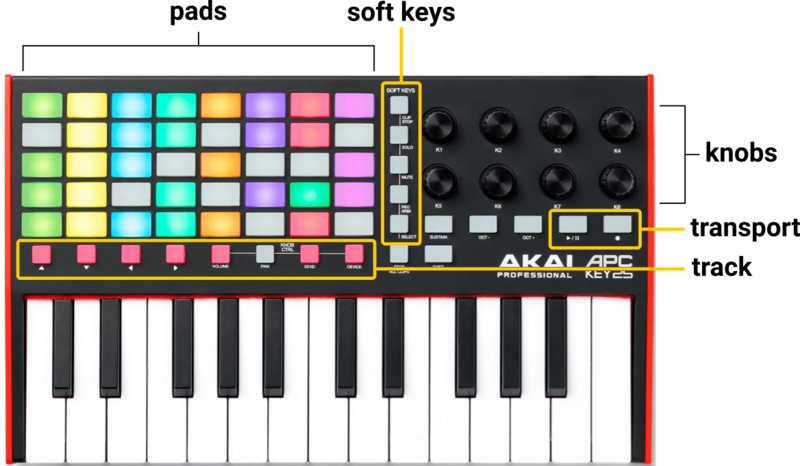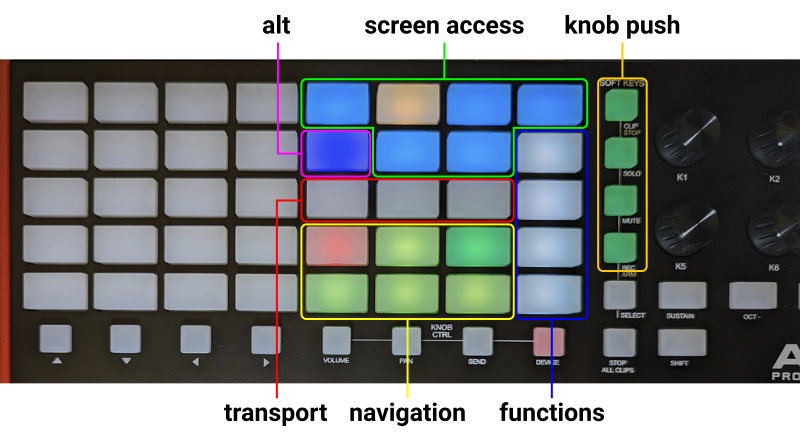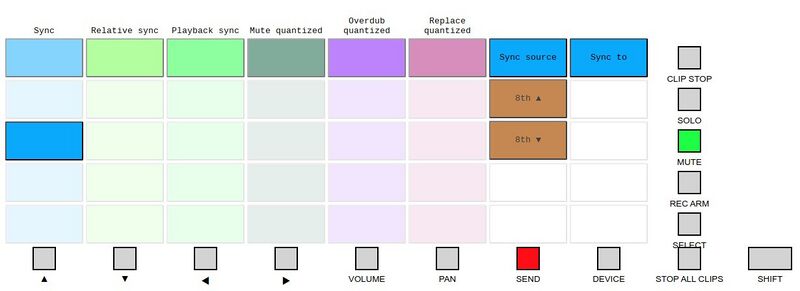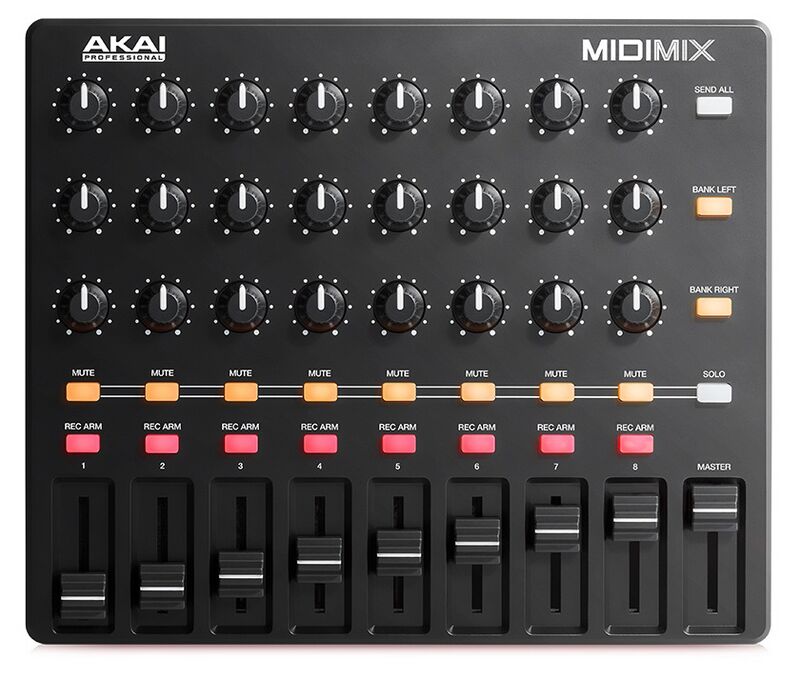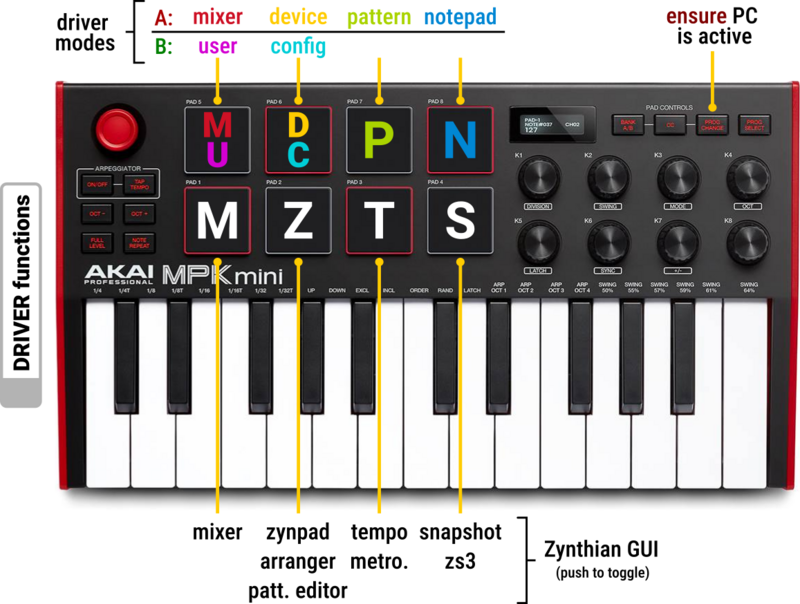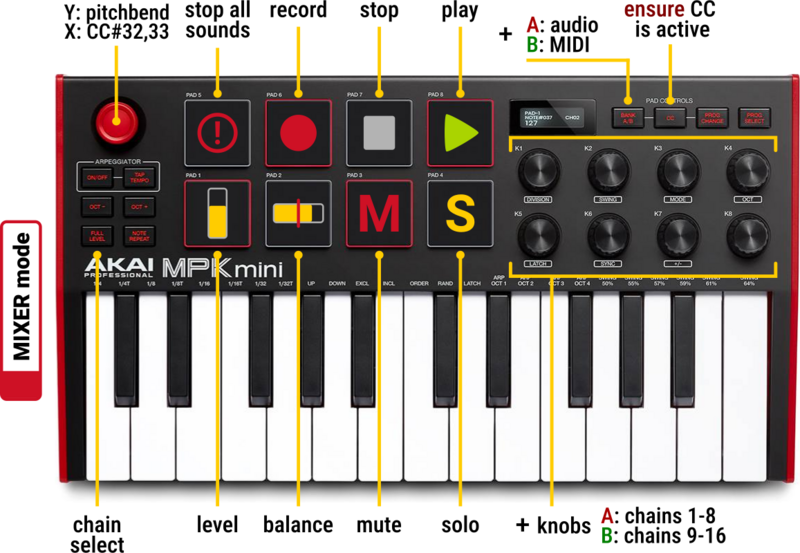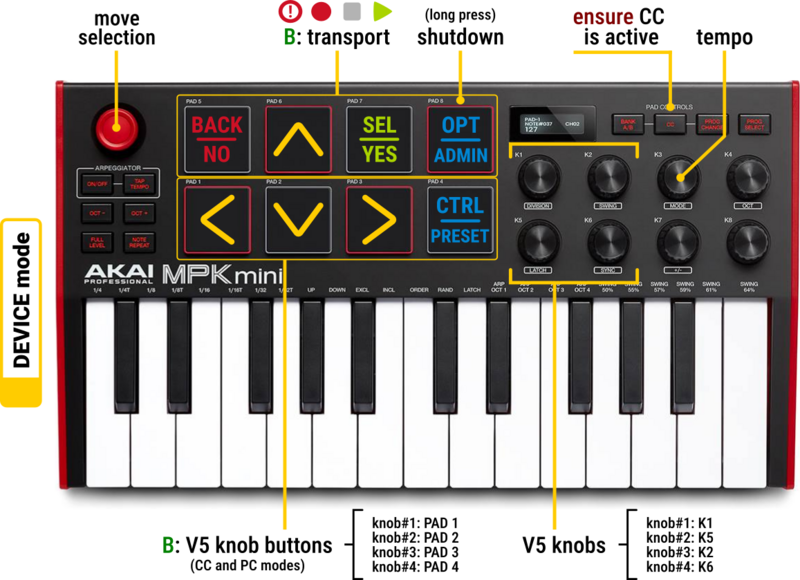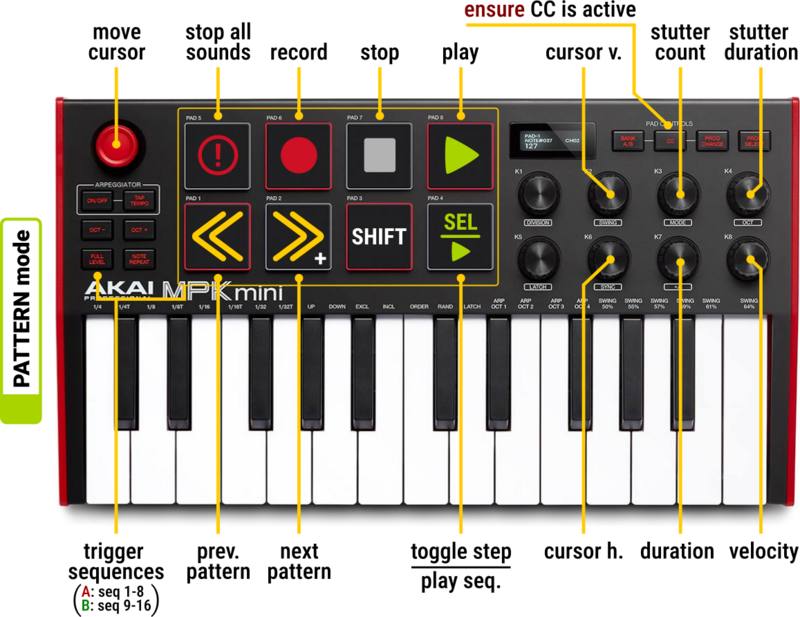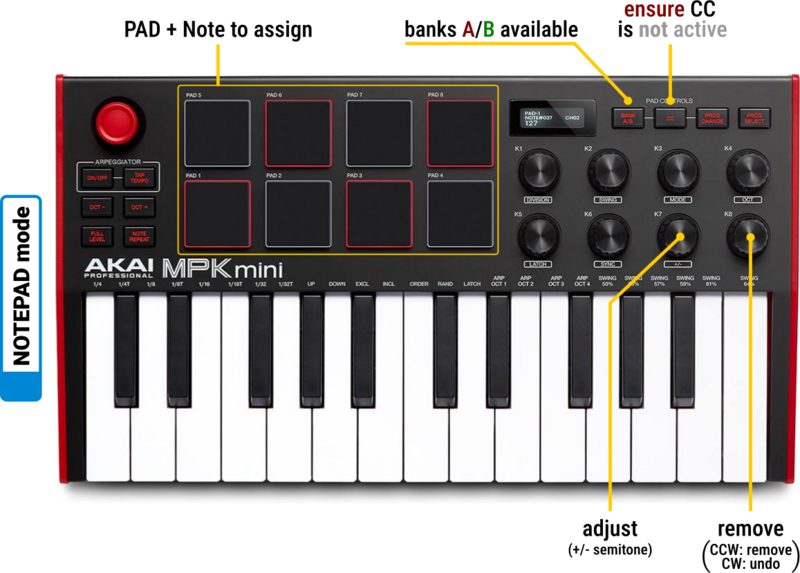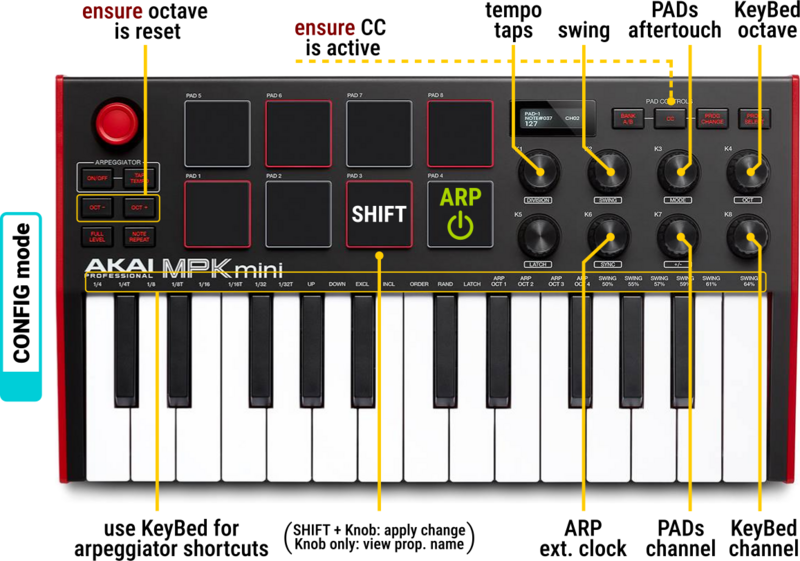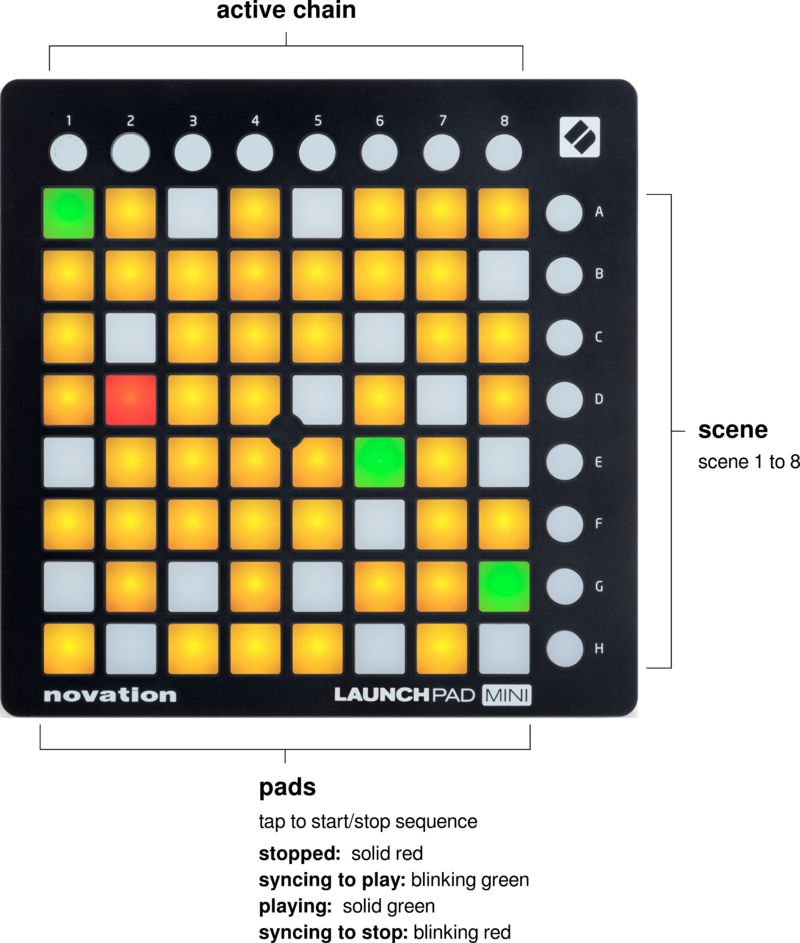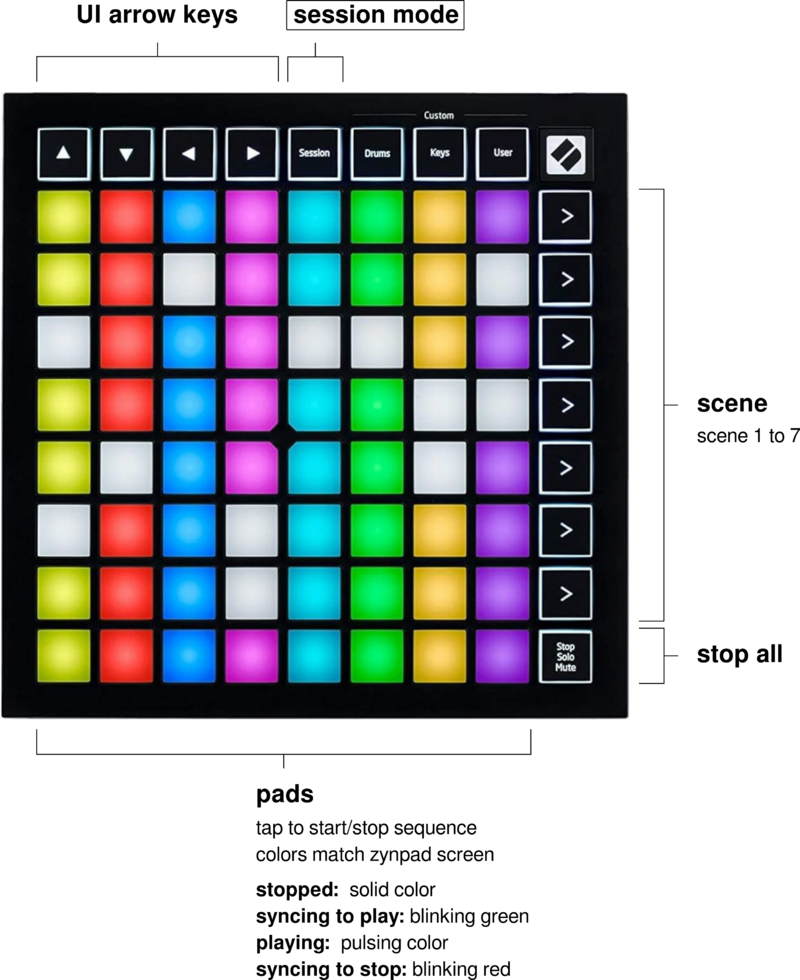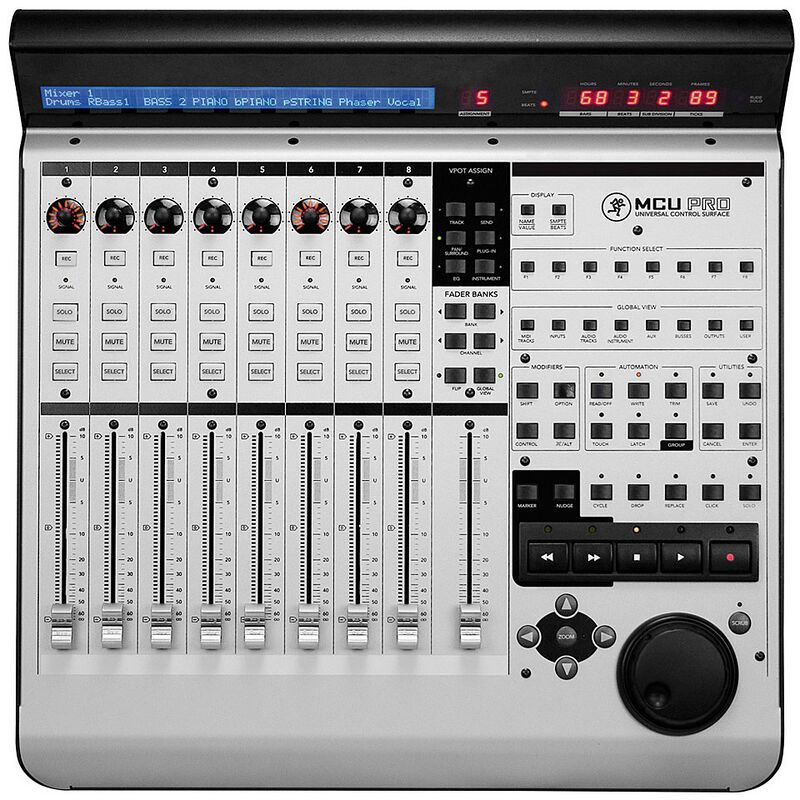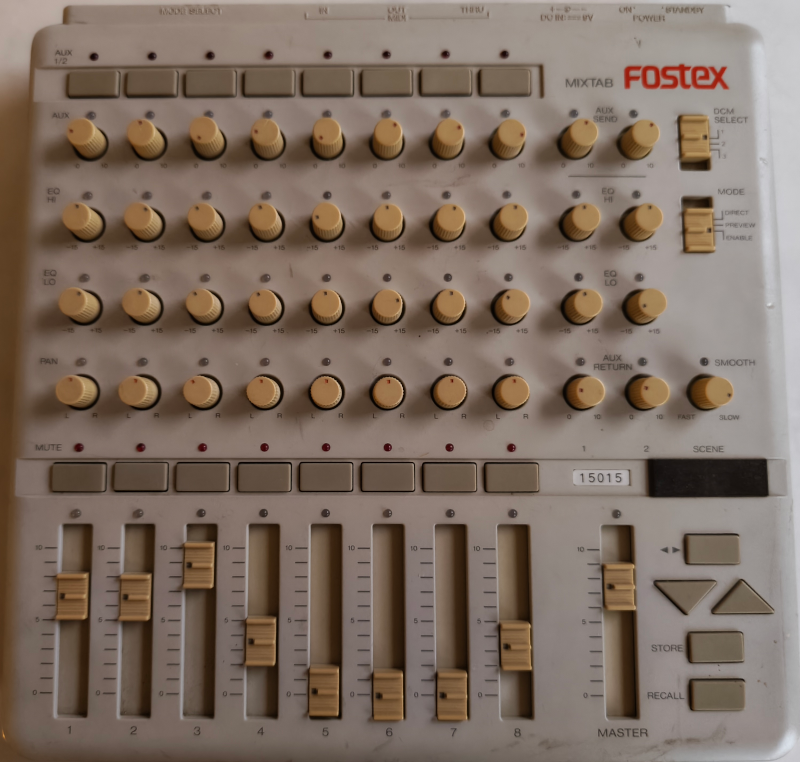Supported plug & play MIDI controllers
Zynthian can be connected to almost any existing MIDI device and you can use the MIDI learning mechanism, as described in the UI user's guide, to assign parameters to faders and knobs in your MIDI controller, for instance. You could also assign pad trigger to notes, etc. But MIDI learning process takes time, it's limiting and you can't get feedback easily. Sometimes it's a lot better to plug a well-known (supported) MIDI controller and get everything mapped automatically. For having this, zynthian implements a controller driver API that allows developers to create specific drivers for specific devices.
This section contain documentation for some of these controller drivers.
1 Akai APC Key25 MK2
This device supports three operation modes:
- The "Mixpad" mode (default), which controls the Zynthian's Mixer and ZynPad.
- The "Device" mode, which handles the Zynthian UI.
- The "Sequencer" mode, which handles the Zynthian Step Sequencer.
1.1 The Mixpad mode
This is the default mode, selected automatically on start. You can also change to it pressing SHIFT + VOLUME or SHIFT + PAN. In this mode you can perform the following actions:
- Tap a pad to start/stop a sequence. The pad LED will show its status as follows (pad color will always match the sequence color):
- Dim solid: Stopped sequence without content (no notes in patterns).
- Bright solid: Stopped sequence with content.
- Blinking slow: Playing sequence.
- Blinking fast: Recording sequence.
- Pulsing: Syncing to play/stop.
1.1.1 Playback and Record Controls
- Toggle audio playback with
PLAY/PAUSEbutton. If Zynthian's ALT mode is active, it will toggle MIDI playback.
- Toggle audio record with
SHIFT+RECORDbutton. If Zynthian's ALT mode is active, it will toggle MIDI recording.
- Stop all sequences of current scene (but not audio/midi playback or recording), doing a short press on
STOP ALL CLIPSbutton; bold press to stop all sequences on all scenes.
- Start/stop sequences of a row, pressing the corresponding SOFT KEY (without modifiers). If there are any sequence playing, they will stop. If there are no sequences playing, it will start those not empty. The action to be run is shown by the LED status (lit will stop, off will start).
- Press
SHIFT+STOP ALL CLIPSfor a 'panic' stop, which stops all sequences, audio and midi playback.
1.1.2 Changing Controller Banks and Zynthian Scenes
- Change controller's bank. There are two banks (1 and 2), which are used to handle up to 16 chains (with the eight track buttons/knobs). Bank 1 is for chains 1 to 8 and bank 2 manage chains 9 to 16. To show current selected bank, press and hold
SHIFT. One of the track buttonsLEFT arroworRIGHT arrowwill light up in red,LEFT arrowis bank 1 andRIGHT arrowis bank 2. You can press one of these buttons while holdingSHIFTto change the bank.
- Change current scene using the track buttons. You need first to select that function by pressing
SHIFT+REC ARMbutton. This function is affected by bank selection, so you can change up to 16 scenes. When selecting a new scene, the ZynPad will be shown.
1.1.3 Modify Chain Settings (mutes, solo etc.)
- Use track buttons to perform a function on chains. The function is chosen by pressing
SHIFT+ one ofSELECT,MUTEorSOLOsoft key buttons. Press and holdSHIFTto see current selected function on soft key buttons (in green). Functions are:SELECT, used to change the selected chain. The key bed (black and white keys) will play on that chain.MUTE, used to mute the corresponding chain.SOLO, used to enable solo in the corresponding chain.
- Mute main chain, pressing
SHIFT+PLAY.
- Use the knobs to modify chains' volume or balance. The function is given by current KNOB CTRL selected:
VOLUMEorPAN(for balance). To change the function, pressSHIFT+VOLUMEorSHIFT+PAN. The knobs are also affected by current controller's bank. Each knob will affect a chain, independently of the selected chain. (K1 -> chain 1, K2 -> chain 2, ...)
- Use
SHIFT+KNOB k1to change volume or balance for main chain (what changes is selected by the current KNOB CTRL function).
1.1.4 Accessing the Step-Sequencer
- Open the StepSeq mode for a given sequence, pressing
SHIFT+ a pad button (more info about this mode in the following section).
- Clear a sequence, pressing any track button + the sequence pad (use SELECT function, and the selected chain's button to avoid changing other settings).
- Start recording a pattern. For this, press
RECORD+ a pad button, which will 1) select the chain associated with the group of the sequence, 2) open the pattern editor for that sequence, 3) start playing the sequence and 4) start recording that sequence. If you press the pad again (without holding any other button), the recording will stop. Press again to stop playback too. You can also control the playback/recording withPLAY/PAUSEorSHIFT+RECORDbuttons.
- If the pattern editor is open, press
SHIFT+UP arrowto go back to ZynPad. Press it again to go to mixer screen.
- Open the ZynPad pressing
SHIFT+DOWN arrow.
1.1.5 Sequence Manager Sub-Mode
- Open the sequence manager (also known as the Seqman sub-mode), pressing
SHIFT+CLIP STOP. If this mode is active, the LED of theCLIP STOPbutton will blink in green, and one ofVOLUME,PANorSENDbuttons will also be solid in red, each one related to a specific function:SEND: this is CLEAR mode. It will remove all patterns of the sequence when its pad is pressed (leaving only a single empty pattern).VOLUME: this is COPY mode. Press the pad of a non-empty sequence to mark it as source (it will blink fast). Press another pad to copy the selected source to it. It will CLEAR the destination sequence, and then copy all the patterns of the source sequence. Press the selected source pad to clear selection.PAN: this is MOVE mode. It works like COPY mode, but also CLEARS the source sequence.- Use
LEFTandRIGHTarrows to move from one scene to another. You can also copy/move patterns between scenes. - Press
SHIFT+SELECTto exit this sub-mode.
1.2 The Device mode
This mode allows you to control the Zynthian UI. You can enable it by pressing SHIFT + DEVICE. If this mode is active, the button DEVICE will blink in red.
As you can see in the image, this mode mimics the Zynthian V5 hardware interface. The upper four buttons are OPT/ADMIN, MIX/LEVEL, CTRL/PRESET and ZS3/SHOT. Next row is ALT, METRONOME and PAD/STEP. The four buttons at the right side (in white) are F1 to F4. In this mode, transport is handled by PLAY/PAUSE and RECORD buttons, and the transport pads are only to show playback/recording status. Navigation buttons are UP, DOWN, LEFT, RIGHT, (in yellow) BACK/NO (in red) and SEL/YES (in green). For the directional keys, you can also use the track keys labelled as such.
The behaviour and status are similar of those in the hardware interface: there is support for short, bold and long press; screen access buttons are blue when no function is selected, green on it's primary and orange on its secondary function; ALT key changes to violet when active (and F1-F4 also change).
The nearest four knobs has the functions of Knob#1 to Knob#4. They can be used to control volume of selected/main chain, move vertically/horizontally in pattern editor or Zynpad, move selected item in menus, etc. Press SHIFT with a knob for a finer (slower) adjustment. The knob press is activated using the first four soft keys to the left (in green), and also has short/bold press support. The mapping is: Knob#1 = (K1, CLIP STOP); Knob#2 = (K5, SOLO); Knob#3 = (K2, MUTE); Knob#1 = (K6, REC ARM). This scheme is very comfortable in the V4 four-corners layout.
1.3 The Step Sequencer mode
This mode allows you to control Zynthian's step sequencer (and also the pattern editor). You can activate it by pressing SHIFT + SEND, or in Mixpad mode pressing SHIFT + a sequence pad. In this mode, the pad matrix is divided in two parts: first four rows (from top to bottom) are the steps of current pattern. The last row is used to assign notes or instruments for easy access (called NotePads in this document). With this mode, you can:
- Press and hold
SHIFTto show the status:- Buttons
UP,DOWN,LEFTandRIGHTwill lit indicating the current Notepad page selected (1, 2, 3 or 4, respectively). - Button
SENDwill lit indicating this mode is selected.
- Buttons
- Open the pattern editor in Zynthian's UI with the current pattern, pressing
SHIFT+DOWN. PressSHIFT+UPto go back.
- Assign an instrument to a NotePad, by pressing the pad + any key of the key bed (black and white keys). The note will be stored in that pad, with the velocity you used. It will be lit with a brightness proportional to the velocity. If you press again the NotePad, it will play the note.
- Remove a NotePad assignment, pressing
STOP ALL CLIPS+ the NotePad. Only the assignment is removed, the steps for that note are kept.
- Select the active instrument, pressing
SHIFT+ a NotePad. It will start pulsating in the color of the instrument's page.
- Change current instruments page, pressing
LEFTandRIGHTarrows. There are 4 pages, each with its own color (1: blue, 2: green, 3: yellow, 4: purple). Upon selecting a new page, one of the first four track buttons will be lit for a second, indicating the active page.
- Toggle a step in the current pattern, pressing a pad in the upper four rows. If the step is on, it will be lit in red (again, the brightness is proportional to the note velocity). Note that for this to work, you will need to first select an active NotePad.
- Extend a step duration, by pressing an active step, holding it for 0.5 seconds, and then pressing another step (it must be greater in sequence). The source step will increase its duration to fill the space between the two pressed steps (included). The extended duration will be lit in orange. If you press the last pad in orange (while still holding the starting step), it will toggle between full and half step.
- Play current sequence pressing the
PLAYbutton. You will see the playhead (in white) moving along the steps. PressingSHIFT+PLAYwill start stage-play, which will update the pattern as it moves along the current track (press any pad to stop stage-play). PressPLAYagain to stop playing.
NOTE: Remember to set the clock source of Zynthian to Internal Send. Otherwise, the playhead will not be shown!
- Panic stop all sounds, pressing
SHIFT+STOP ALL CLIPS. Any sound will stop immediately.
- Adjust the tempo rotating the knob
K1. The TEMPO screen will be shown briefly in the UI. PressSHIFTwhile rotating for a finer adjustment (0.1 BPM).
- Adjust sequence's chain level rotating the knob
K2. Also, the Mixer screen will be shown briefly in the UI while adjusting. PressSHIFTwhile rotating for a finer control.
1.3.1 Adjust Notepad Parameters
- Change the velocity, duration, stutter count or stutter duration of a step or NotePad, pressing the corresponding pad and rotating one of the following knobs:
K1: note durationK2: note velocityK3: stutter countK4: stutter duration
1.3.2 Control Levels - Adjust Parameters With Pads
- You can also change these properties using control levels. With a control level, you will use the columns of the pad matrix to see and change the level of certain property of a step or NotePad. These are the key bindings:
- Press
VOLUME+ a step/NotePad to activate the control level for velocity adjustment.VOLUME's track button will be solid lit in red. PressVOLUMEagain to exit control level mode. - Press
SEND+ a step/NotePad for stutter count adjustment.SEND's track button will be solid lit in red. - In stutter count control level, press again
SENDto switch to stutter duration adjustment.SEND's track button will blink in red. PressSENDagain to exit control level mode. - If, instead of pressing a pad, you press
VOLUMEorSEND+ one of the 5 soft keys to the right, it will open the control level for each step or NotePad in that row. Now, just pressing another soft key will switch to the related row. - You can switch between different control levels by pressing the function that is not currently active (otherwise, it will exit that control level).
- Pressing
SHIFT+ any pad in the active column will set the property value to zero (or 1, in case of stutter duration). - Press a pad in any active column to change the related step/NotePad value. Press top lit pad to switch between full and half value (the brightness will also change). The following table shows the relation between rows and values of each function (rows are from bottom to top, values are for Full/Half):
- Press
| Row | Velocity | Stutter Count | Stutter Duration |
|---|---|---|---|
| 1 | 25 / 12 | 2 / 1 | 2 / 1 |
| 2 | 50 / 38 | 4 / 3 | 4 / 3 |
| 3 | 76 / 63 | 8 / 6 | 8 / 6 |
| 4 | 101 / 88 | 12 / 10 | 20 / 10 |
| 5 | 127 / 114 | 20 / 15 | 40 / 30 |
1.3.3 Quick Change and Copy Pattern
- Quick change pattern in current track, by pressing
SHIFT+LEFT/RIGHT. If next pattern (to the right) does not exist, it will be created (up to 8 patterns). The bottom row of the pad matrix will show current pattern (in red), and also where there exists a pattern (bright white) or not (dim white).
- Roll current pattern to a side, pressing
SHIFT+SELECT+LEFTorRIGHT. This will copy current pattern to the pattern on the left or right.
1.3.4 Pattern Manager Mode
- You can also enter the arranger sub-mode (also called PatMan, for pattern manager), to handle the patterns of current track, pressing
SHIFT+SELECT. This mode will also open the arranger in Zynthian's UI. In this sub-mode, you can:- Change current pattern, just pressing a pad where there is a pattern (bright white). The selected pattern will be shown in red. You can also move to the left or right using the track buttons.
- Clear a pattern, pressing
MUTE+ pattern pad. It will remove all notes on that pattern. The pad will blink briefly in red. - Remove a pattern, pressing
STOP ALL CLIPS+ pattern pad. The pattern will be removed, and all patterns to the right will slide to fill the gap. - Create a new empty pattern, if there are no pattern to the right, by pressing
SHIFT+RIGHT. - Roll current pattern to one side, pressing
SHIFT+SELECT+LEFTorRIGHT. - Copy a pattern to another pattern, pressing source pattern pad + destination pattern pad. The destination will blink briefly in green.
- To exit this sub-mode, press
SELECT. Zynthian's UI will also go to the previous screen.
2 Akai APC Key25 MK2 + SL
This is a driver for the Akai APC Key25 MK2 with the exact same functionality as the above driver. With the exception that SHIFT+pad at the bottom right serves to enter SooperLooper mode, with various submodes.
SooperLooper Mode starts in the Looper Mode.
Besides that, there are two Levels modes, one Pan mode, one Sync/Quantize mode, and two Session modes.
The present mode is indicated by the four buttons Volume, Pan, Send and Device.
Volume:
Cycles through the two Levels modes, and back to Looper mode.
Pan:
Opens/closes the Pan mode
Send:
Opens/closes the Sync/Quantize mode.
Device:
Cycles through the two Session Modes, and back to Looper mode
2.1 Looper mode
This is the basic, default, mode we start with. If this mode is on, none of the four indicators is lit.
The 8×5 grid of RGB Leds control looping commands and reflect the current state of a loop.
Adding a loop: press the leftmost pad on an empty loop row to add a mono loop, press the second pad to add a stereo loop. 3rd for three channels, 4th for four. NOTE: more than 2 would not make sense at the moment on a Zynthian.
Remove the last loop by pressing any of pad 5-8 on an empty loop. This cannot be undone.
The first row shows the column commands for all the tracks.
The commands are:
Rec/Overdub (red/purple)
Multiply (amber)
Insert (warm pink)
Replace (pink light
Substitute (pink)
Oneshot (light green)
Trigger (green)
Pause (lime).
Record will change to overdub on non-empty loops.
The following four rows initially show the first four loops.
Their pads do the same as the all-loop pads in the same position.
For the Rec/Overdub pad, holding the Up (▲) pad while pressing a Rec/Overdub pad will reverse the action. This means it forcing record when overdub would be the normal action. You can also use this to go straight into overdub from recording.
Pressing one of these pads and holding it for more than 1 second will make that pad function as a momentary toggle.
When a pad's function is active, the entire row will have that color. Overdub being purple.
The brightness of a loop row indicates the playing position in the loop.
When a loop is blinking quickly, it is waiting, e.g. to record.
2.1.1 Groups
The first 5 'global' pads contain five groups. You can use them for grouping loops used for chorus/verse/bridge etc.
If loops are assigned to a group pad pressing that group pad will unmute its loops and mute all other loops.
2.1.2 Soft keys
Solo + any loop pad (toggle-)soloes that loop.
Mute + any loop pad toggles whether that loop is muted.
Mute + the top row toggles muteness of all loops.
Stop all clips mutes all clips.
Shift+Stop all clips unmutes all clips.
Clip stop and Rec Arm are still free.
Select toggles the group assign mode. When this is active, press one of the five group pads and select which loops it
contains. NOTE: groups are not saved, nor restored, with sessions or
in a snapshot. They are ephemeral and act globally.
Shift + a row's soft key Sets the selected loop in SooperLooper. The selected loop is what is used in Level mode 2, and also often a target of other controllers (such as a single pedal).
The softkey of the selected loop will be lit green. When the mode is active targeting the selected loop, such as Levels Mode 2, the softkey will pulsate in green.
2.1.3 Track buttons
Shift + ▲ and Shift + ▼:
Shift plus the Up or Down key shifts the loops in view, as long as there are some. During Shift press, you'll see a number indicating the top loop.
◀ and ▶:
The left and right arrows + a pad in the same column perform Undo and Redo on a loop.
Pressing the left arrow + a pad in a column to the left of its column performs Undo All on a loop.
Pressing the right arrow + a pad in a column to the right of its column performs Redo All on a loop.
I found this to be quite intuitive: undo/redo to the extreme.
◀ plus the 'global record' on the top left this way acts as a nice shortcut to clear all loops.
2.1.4 Knobs
The (top) Knobs 1-4 control the wet signal (volume level) for the 4 displayed loops.
The (bottom) Knobs 5-8 control the pan of the 4 displayed loops.
2.2 Session mode 1: session save mode
Pressing a pad saves the current session to one of the 40 locations.
Invoke by pressing Device button once. The Device button will light up red.
The last recorded or loaded session by the driver during the current session is indicated by a blinking pad. We have no mechanism to detect sessions loaded via the preset and zs3 mechanism.
Any pad with a session is lit up bright.
When you want to save to a pad that already contains a session, you have to confirm with a bright green pad for 'Yes', or a bright red pad with 'No', next to the pad in question.
2.3 Session mode 2: Session load mode
Pressing a pad loads a session stored under that pad.
Invoke by pressing Device twice. The Device button will light pulsate red.
The last recorded or loaded session by the driver during the current session is indicated by a blinking pad.
There is no confirmation step before loading, so any changes you may have are lost when loading a new session.
2.4 Levels mode 1: volume (wet) levels for all displayed loops
Invoke by pressing Volume button once. The Volume button will light up red.
You can use the pads to adjust volume levels. The top row is the out level of all loops combined.
2.5 Levels mode 2: 6 levels for selected loop
Invoke by pressing Volume button twice. Both the Volume button and the softkey next to the selected loop will pulsate red.
Peak meter (red) - Record Threshold (red) - Input Gain (lime) - Wet (blue - think water) - Dry (dark grey) - Feedback (purple)
You can use the pads, and knobs 2-6 will control the levels of each column.
2.6 Pan mode
Invoke by pressing Pan button once. The Pan button will light up red.
The pan settings for each displayed loop is shown. Stereo loops show the left channel as red, the right one as blue.
Mono loops show the setting simply in a brighter color of the current state.
Panning values can be edited via the pads, but especially for stereo loops, this may look weird, since they are hard-panned to start with.
2.7 Sync/Quantize mode
The first 6 pads in the top row toggle sync, relative sync, playback sync, mute quant, overdub quant and replace quant for all loops.
The pads in the columns below toggle it on individual loops.
Shifting loops is possible as in the Looper Mode.
The 7th pad in the top row cycle through Sync source (off, loop1 (blue) -- last loop (all dark blue), internal (white), MIDI (orange), Jack (red)).
The (newly) selected function/loop # is indicated in the grid.
The 8th pad in the top row cycle through Sync to (off, MIDI(orange), 8th(brown), cycle(blue)).
The soft key next to the top row can be used to inspect sync/quant settings in the grid.
The two light brown pads below the top row increase/decrease the number of 8th within a cycle. Press both at same time to view but not change.
While one of those is pressed, number of 8ths is indicated as brown pads filling up from the left bottom. Pressing ANY pad sets it to that number of 8ths. This allows for easy setting of e.g. 4/8 or 2/8, so that you easily create smaller loops than the one synced to, yet still be in time. Their own placement--at 23/8 and 31/8--is large prime enough not likely to pose a problem.
The second soft key from the top can be used to inspect/set eighths as well.
3 Akai MIDI MIX
3.1 ZynMixer driver
This Akai MIDIMix driver maps the basic mixer's functionality. Chains are numbered from left to right as shown in the zynmixer screen. Note that these numbers are not MIDI channels!
- Bank Left: Strips assigned to chains 1-8
- Bank Right: Strips assigned to chains 9-16
- Master Slider: Main volume
- Strip 1-8: Chain's mixer control, depending on bank selection
- Upper Knobs: The 2 upper knobs are available for MIDI learning.
- Lower Knob: Chain's balance
- Mute: Chain's mute switch
- Solo: Push
SOLOto see solo status. PushSOLO+MUTEfor toggling solo. - Rec Arm: Red light indicates active chain. Push to set active chain.
- Slider: Chain's volume
4 Akai MPK mini MK3
The driver for this device has 4 main operation modes:
- The Mixer mode (default) which handles Zynthian's Mixer.
- The Device mode, to control the Zynthian GUI (Graphical User Interface).
- The Pattern mode, for controlling the Zynpad and Pattern Editor.
- The NotePad mode, which is used to assign the notes that the PADs will play in note mode.
There are two more minor modes, which are:
- A User mode, where every PAD and KNOB is available for MIDI learn.
- A Config mode, used to configure the MPK internal settings, like the channels, the arpeggiator, and more.
Each mode is shown in the MPK display when active. PADs 1-4 A are used as direct access to some of Zynthian GUI screens:
PAD 1 A: toggles between Zynthian's mixer and audio levels.PAD 2 A: cycles between Zynpad, the arranger and pattern editor.PAD 3 A: opens the tempo and metronome screen.PAD 4 A: toggles between snapshot and ZS3 screens.
Each one of these functions or modes is available on every operation mode or screen. Just ensure that PC (PROG CHANGE) is active on the MPK.
4.1 The Mixer mode
This is the default mode, but you can switch back to it with PROG CHANGE:PAD 5 A. You should see Zynthian MIXER in the display of the MPK. In this mode, you can use the Knobs to adjust chains settings. The general rule is: PAD x + Knob y to adjust the setting x of chain y. You can adjust chains 1 to 8 in bank A, and chains 9 to 16 in bank B. The functions that you can change are:
NOTE: Remember to put PAD CONTROLS in CC mode. The pads in note mode will only trigger the assigned notes.
PAD 1 A+KNOBs 1-8to adjust level of chains 1-8.PAD 1 Bfor chains 9-16.PAD 2 A+KNOBs 1-8for balance (panning) of chains 1-8.PAD 2 Bfor chains 9-16.PAD 3 A+KNOBs 1-8to toggle mute of chains 1-8.PAD 3 Bfor chains 9-16. Clockwise to set mute, counter clockwise to clear mute.PAD 4 A+KNOBs 1-8to toggle solo of chains 1-8.PAD 4 Bfor chains 9-16. Same rules apply as for muting.
The driver will remember the last function pressed, so for adjusting chains 1-8, you can just press the desired PAD (1-4), release it, and then adjust using the knobs. All knobs will affect that PAD's function. For chains 9-16, you need the keep the PAD pressed.
In this mode, there is also support for transport controls:
PAD 5 A/Bfor stop all sounds (PANIC button).PAD 6 Afor toggle audio record.PAD 6 Bwill toggle MIDI record.PAD 7 Awill trigger audio stop, whilePAD 7 Bwill trigger MIDI stop.PAD 8 Ais for togging audio playback, andPAD 8 Bwill toggle MIDI playback.
If you activate the FULL LEVEL option in the MPK, then PAD's function changes to select chain. PADs in bank A will select first 8 chains, and bank B is used to select chains 9-16.
The joystick in this mode affects the pitch-bend (in the Y axis), and sends CC messages, CC#32 for -X (left) and CC#33 for +X (right) values, available for MIDI learning.
4.2 The Device mode
This mode is used to control Zynthian's GUI. You can activate it by pressing PROG CHANGE:PAD 6 A anytime. The MPK display will show the label Zynthian DEVICE. In this mode, you have the following options:
NOTE: Remember to put PAD CONTROLS in CC mode. The pads in note mode will only trigger the assigned notes.
- In bank A:
- Use
PADs 1-3andPAD 6to move around the user interface (up, down, left and right, as shown in the diagram). You can also use the joystick for this. - Cancel or go back with
PAD 5. - Accept or select an item, using
PAD 7. - Launch the options menu, or the admin menu, by a short press in
PAD 8. Each press will toggle between these two screens. With a long press, it will shutdown the system (a confirm dialog will appear). - Open the controls or preset screen of a chain, doing a short press in
PAD 4. In Zynpad, a long press ofPAD 4/7will open the pattern editor for the selected sequence.
- Use
- In bank B:
- Upper row of PADs is used for transport buttons, just like in the mixer mode:
PAD 5: stop all sounds (panic button).PAD 6: toggle audio record.PAD 7: stop audio.PAD 8: toggle audio playback.
- Lower row is used as V5 Knob press buttons. The mapping is from
PAD 1toPAD 4, which are used as Knob#1 to Knob#4 press buttons. These buttons are available in CC and PC mode. This is mainly needed for MIDI learning features, where a CC message would establish the control's MIDI learn. CC is needed when a bold/long press is required.
- Upper row of PADs is used for transport buttons, just like in the mixer mode:
This mode also maps the V5 Knobs to K1, K5, K2, K6, in that order.
Knob K3 is used to adjust the tempo. When rotated, the Zynthian tempo screen will be shown briefly. This tempo setting is synchronized with the MPK.
NOTE: The MPK resolution is 1BPM, but Zynthian is 0.1BPM; take this into account to avoid drifting.
4.3 The Pattern mode
This mode works only in Zynthian's Zynpad, Arranger or Pattern Editor. To activate it, press PROG CHANGE:PAD 7 A. You should see Zynthian PATTERN in the display of your MPK. Note that all the following PADs are assumed to be in bank A.
NOTE: Remember to put PAD CONTROLS in CC mode. The pads in note mode will only trigger the assigned notes.
In any screen (Zynpad, Arranger or Pattern Editor), you can:
- Move the cursor using the joystick, or
K2for vertical andK6for horizontal displacement. - Press and hold
PAD 3as SHIFT, when required.
In Pattern Editor, you will have the following functionality:
- Transport controls using the upper row PADs, following the same arrangement as in Mixer mode (
PAD 5: stop all sounds,PAD 6: toggle record,PAD 7: stop,PAD 8: toggle playback). - Move along patterns of the same track in current sequence. Press
PAD 1for previous pattern, andPAD 2for next. If there are no more patterns in current track, you can create a new one pressingSHIFT+NEXT(i.e:PAD 3+PAD 2) while visiting the last pattern. - Toggle step in cursor's position, pressing
PAD 4. - Adjust the selected step, using the following Knobs:
- Step's duration:
K7. It will change in increments of 0.1 steps, or, by pressingSHIFT, in 0.5 steps. - Step's velocity:
K8. - Step's stutter count:
K3. Ranges from 0 to 32. - Step's stutter duration:
K4. Ranges from 1 to 96, and is measured in clock cycles.
- Step's duration:
In Zynpad, you may:
- Toggle playing the selected sequence, by pressing
PAD 4. - If the MPK is in FULL LEVEL, each PAD can launch/stop a sequence. PADs in bank A, for sequences between 1 and 8, and bank B for sequences 9-16.
- Toggle playing the selected sequence, by pressing
4.4 The NotePad mode
The purpose of this mode is to modify the notes that the PADs will send in note mode (i.e. neither CC or PROG CHANGE active). You can switch to this mode by pressing PROG CHANGE:PAD 8 A. You should see Zynthian NOTEPAD in the display of the MPK.
NOTE: Unlike the other modes, this mode only works if PAD CONTROLS are in note mode.
To assign a note to a PAD, press that PAD and, without releasing it, press any key of the KeyBed. Press the pad again to check the note (it may be sent to a different chain, depending on PAD/KeyBed channels and Zynthian settings). In this mode, both banks A and B are available for note binding.
You can remove a note from a PAD pressing that PAD and, without releasing it, turning K8 counter clock-wise. The removal will be done when you release the PAD, so, if you didn't want to remove it (and didn't release the PAD), just turn the Knob clock-wise again.
Using the Knob K7 on a PAD will adjust its pitch (note) by a semitone, up and down the scale.
4.5 The User mode
This is a special mode, with no other purpose that letting you all the available controls for MIDI learning. Only PC 0-7 and 12,13 are NOT available (as they are used for changing modes and Zynthian's shortcuts). You can switch to this mode by pressing PROG CHANGE:PAD 5 B. You should see Zynthian USER in the display of the MPK.
This is the available configuration:
- PADs channel is the assigned in Config mode (see below).
- PAD notes are the assigned in NotePad.
- PAD CCs are in range [40-47] for bank A, and [48-55] for bank B.
- PC PADs 1, 2, 3, 4, 7 and 8 (all in bank B) are available.
- All Knobs are available, and their CCs goes from 56 to 63.
- Joystick Y channel is mapped as pitchbend.
- Joystick X channel is set as dual mode, with CCs 64 (left side) and 65 (right side).
4.6 The Config mode
This is also a special mode, used to configure the MPK device internal settings, like the channel where the PADs will send their notes, or the arpeggiator settings.
Rationale: while you can use the MPK arpeggiator or NOTE REPEAT buttons to change some of these settings, they will be overwritten on next mode change (as they are inside the MPK and could not be retrieved). Moreover, there are settings that could only be changed using the MPK Program Editor, so this mode will help you in that case. Zynthian will store the changes you made here per snapshot basis, so that's another reason for using this mode.
NOTE: Remember to put PAD CONTROLS in CC mode. The pads in note mode will only trigger the assigned notes. ALSO, ensure that KeyBed octave is in the middle (neither OCT+ nor OCT- is brightly lit).
In this mode, all notes of the KeyBed are used as shortcuts for the arpeggiator settings. See the MPK KeyBed labels to check the purpose of each one. Also note that:
PAD 3 Ain CC mode is used as SHIFT.PAD 4 Ain CC mode toggles on/off the arpeggiator.
For other settings, you can use the Knobs. Move a Knob to see in the MPK display its function (but it won't change anything), and SHIFT + move Knob to actually change that property (changes are applied on SHIFT release). This is the settings mapping:
K1: changes tempo taps, the number of times you need to press the buttonTAP TEMPOto change it. Ranges from 2 to 4.K2: to modify the arpeggiator swing, giving you a finer adjustment than using the KeyBed shortcuts.K3: to change the PADs aftertouch settings. Values are 0: Off, 1: Channel Aftertouch, 2: Polyphonic Aftetouch.K4: for changing the KeyBed octave. A value of 4 is the default middle octave, less than 4 is for lowering the octave, and bigger that 4 increases the octave. NOTE: If you want to change this value, please note that it will affect the KeyBed immediately, so any shortcut that you use later on would be displaced. Just adjust this as the last value, or reset octave before using the shortcuts.K6: for setting the arpeggiator clock source as EXT (external). Set it to 1 for using an external clock, or 0 to use the internal clock.K7: lets you change the channel of the PADs.K8: to modify the channel of the KeyBed.
5 Novation LAUNCHPAD MINI MK1
5.1 ZynPad driver
6 Novation LAUNCHPAD MINI MK3
6.1 ZynPad driver
7 Novation LAUNCHPAD PRO MK2
7.1 ZynPad driver
It works much like the Launchpad Mini MK3.
8 Novation LAUNCHPAD PRO MK3
8.1 ZynPad driver
It works much like the Launchpad Mini MK3.
9 Novation LAUNCHPAD X
9.1 ZynPad driver
It works much like the Launchpad Mini MK3.
10 Novation LAUNCHKEY MINI MK3
10.1 ZynPad driver
11 Behringer MOTÖR 61 / 49
This driver is focused in stage control of setBfree and Pianoteq engines. It also includes the mode enforcer that can be controlled from the pads (notes). This driver must be loaded in the device's MIDI port 1.
This is a summary of how keyboard controllers are used:
| Control | Engine | Parameter |
|---|---|---|
| Master Fader | setBfree | Global Volume |
| Faders 1-8 | setBfree | Upper Drawbars (except the highest pitched) |
| Faders 9-16 | setBfree | Lower Drawbars (except the highest pitched) |
| Faders 17-24 | setBfree | Pedal Drawbars (except the highest pitched) |
| Encoders 1-4 | setBfree | 1:highest pitched DB, 2:percussion, 3:vibrato, 4.reverb |
| Encoders 5-8 | Pianoteq | 1:volume, 2:dynamics, 3:reverb mix, 4:reverb duration |
| Pads 1-32 (as notes -> Prg Change OFF) | Mode Enforcer | Pad 1 always returns to Chromatic mode |
And here the detailed assignment:
| Control | Engine | Parameter |
|---|---|---|
| Master Fader | setBfree | Global Volume |
| Faders Bank 1-8 | setBfree | Upper Drawbars |
| Fader 1 | setBfree | Upper DB 16 |
| Fader 2 | setBfree | Upper DB 5 1/3 |
| Fader 3 | setBfree | Upper DB 8 |
| Fader 4 | setBfree | Upper DB 4 |
| Fader 5 | setBfree | Upper DB 2 2/3 |
| Fader 6 | setBfree | Upper DB 2 |
| Fader 7 | setBfree | Upper DB 1 3/5 |
| Fader 8 | setBfree | Upper DB 1 1/3 |
| Faders Bank 9-16 | setBfree | Lower Drawbars |
| Fader 1 | setBfree | Lower DB 16 |
| Fader 2 | setBfree | Lower DB 5 1/3 |
| Fader 3 | setBfree | Lower DB 8 |
| Fader 4 | setBfree | Lower DB 4 |
| Fader 5 | setBfree | Lower DB 2 2/3 |
| Fader 6 | setBfree | Lower DB 2 |
| Fader 7 | setBfree | Lower DB 1 3/5 |
| Fader 8 | setBfree | Lower DB 1 1/3 |
| Faders Bank 17-24 | setBfree | Pedal Drawbars |
| Fader 1 | setBfree | Pedal DB 16 |
| Fader 2 | setBfree | Pedal DB 5 1/3 |
| Fader 3 | setBfree | Pedal DB 8 |
| Fader 4 | setBfree | Pedal DB 4 |
| Fader 5 | setBfree | Pedal DB 2 2/3 |
| Fader 6 | setBfree | Pedal DB 2 |
| Fader 7 | setBfree | Pedal DB 1 3/5 |
| Fader 8 | setBfree | Pedal DB 1 1/3 |
| Encoders Bank 1-8 | setBfree & Pianoteq | |
| Encoder 1 | setBfree | Upper Drawbar 1 (highest pitch) |
| Encoder 2 | setBfree | Percussion on/off |
| Encoder 3 | setBfree | Vibrato routing |
| Encoder 4 | setBfree | Reverb |
| Encoder 5 | Pianoteq | Volume |
| Encoder 6 | Pianoteq | Dynamics |
| Encoder 7 | Pianoteq | Reverb Mix |
| Encoder 8 | Pianoteq | Reverb Duration |
| Encoders Bank 9-16 | setBfree | |
| Encoder 1 | setBfree | Lower Drawbar 1 (highest pitch) |
| Encoders Bank 17-24 | setBfree | |
| Encoder 1 | setBfree | Pedal Drawbar 1 (highest pitch) |
| Pads Bank 1-8 | Mode Enforcer | 7-note modes (white keys) |
| Pad 1 | Mode Enforcer | Chromatic |
| Pad 2 | Mode Enforcer | Major |
| Pad 3 | Mode Enforcer | Minor |
| Pad 4 | Mode Enforcer | Harmonic Minor |
| Pad 5 | Mode Enforcer | Melodic Minor |
| Pad 6 | Mode Enforcer | Dorian |
| Pad 7 | Mode Enforcer | Mixolydian |
| Pad 8 | Mode Enforcer | Lydian |
| Pads Bank 9-16 | Mode Enforcer | 7-note modes (white keys) |
| Pad 1 | Mode Enforcer | Chromatic |
| Pad 2 | Mode Enforcer | Phrygian |
| Pad 3 | Mode Enforcer | Locrian |
| Pad 4 | Mode Enforcer | Super Locrian |
| Pad 5 | Mode Enforcer | Bhairav |
| Pad 6 | Mode Enforcer | Hungarian Minor |
| Pad 7 | Mode Enforcer | Minor Gypsy |
| Pad 8 | Mode Enforcer | Spanish (8 notes!) |
| Pads Bank 17-24 | Mode Enforcer | 5-note modes (black keys) |
| Pad 1 | Mode Enforcer | Chromatic |
| Pad 2 | Mode Enforcer | Minor Pentatonic |
| Pad 3 | Mode Enforcer | Major Pentatonic |
| Pad 4 | Mode Enforcer | Hirojoshi |
| Pad 5 | Mode Enforcer | In-Sen |
| Pad 6 | Mode Enforcer | Iwato |
| Pad 7 | Mode Enforcer | Kumoi |
| Pad 8 | Mode Enforcer | NONE |
| Pads Bank 25-32 | Mode Enforcer | Other modes (custom keys) |
| Pad 1 | Mode Enforcer | Chromatic |
| Pad 2 | Mode Enforcer | Diminished |
| Pad 3 | Mode Enforcer | Whole-Half |
| Pad 4 | Mode Enforcer | Spanish |
| Pad 5 | Mode Enforcer | Whole Tone |
| Pad 6 | Mode Enforcer | Minor Blues |
| Pad 7 | Mode Enforcer | Pelog |
| Pad 8 | Mode Enforcer | NONE |
12 Korg nanoKONTROL
12.1 ZynMixer driver
Not supported yet!
13 Korg nanoKONTROL-2
13.1 ZynMixer driver
This Korg nanoKONTROL2 driver maps the mixer screen and transport buttons basic functionality. Chains are numbered from left to right as shown in the zynmixer screen. Note that these numbers are not MIDI channels!
13.1.1 Common buttons
- Cycle: SHIFT mode button. Toggle alternate functions as described below.
- Track Left: UI Left arrow
- Track Right: UI RIGHT arrow
- Marker Set: UI SELECT button
- Marker Left: UI UP arrow
- Marker Right: UI DOWN arrow
- Transport FRWD (Left): Bank 1. Strips assigned to chains 1-8. When light, it acts as the UI BACK button.
- Transport FFWD (Right): Bank 2. Strips assigned to chains 9-16
13.1.2 NORMAL mode
- Transport STOP: Stop audio play and reset play position.
- Transport PLAY: Start/Resume/Pause audio play. Light indicates playing state.
- Transport REC: Start/Stop audio recording. Light indicates recording state.
- Strip 1-8: Chain's mixer control, depending of bank selection
- Knob: Chain's balance
- Slider: Chain's volume
- M: Chain's mute switch
- S: Chain's solo switch
- R: Red light indicates active chain. Push to set active chain.
13.1.3 SHIFT mode
- Transport STOP: Stop MIDI play and reset play position.
- Transport PLAY: Start/Resume/Pause MIDI play. Light indicates playing state.
- Transport REC: Start/Stop MIDI recording. Light indicates recording state.
- Knobs 1-8: Available for engine control (MIDI learning).
- Strip 1-7: Chain's mixer control, depending of bank selection
- Slider: Chain's volume
- M: Chain's mute switch
- S: Chain's solo switch
- R: Chain's recorder arm switch
- Strip 8: Main mixer control
- Slider: Main volume
- M: Main mute switch
- S: Global solo indication. Switch does nothing.
- R: Main recorder arm switch
14 Mackie Control
This driver can be loaded for devices that support MCU protocol and variants. For instance:
- Original MCU hardware
- Behringer X-Touch
- Behringer BCF2000
- Behringer MÓTOR 49/61 (MC mode)
- Etc.
You can configure the mapped actions via YAML config file.
15 Fostex Mixtab
This driver uses MIDI input and output to communicate with a Fostex Mixtab control surface. The Mixtab was released in 1992 as a hardware controller for the Fostex DCM100 1U rack mounted 8-channel stereo mixer. It provides controls for each of that mixer's parameters, the ability to switch between up to 3 mixer units and offers absolute and pick-up modes of operation. This driver maps the hardware controls to relevant parameters in zynthian (mostly zynmixer).
Each fader strip controls the corresponding audio channel (audio, synth, etc.) in the same order as displayed in zynthian. The DCM SELECT switch moves the control between the first, second and third groups of 8 chains, allowing control of up to 24 chains. The last fader controls the main mixbus.
Each channel strip has the following controls:
- AUX
- EQ HI
- EQ LO
- PAN
- MUTE
- FADER
Fader and pan control the level and pan/balance of each chain. The Mute button sends volume 0, not seperate mute signal.
ZS3 is saved by double pressing the STORE button within 1.5s, but the display must stop flashing before the second press.
The SMOOTH control adjusts tempo.
The AUX EQ act as encoders 1..4.
Other controls act as learnable controllers. (Note AUX1 & AUX2 send the same CC, each over the range 0..63 and 63..127 respectively.)
16 Technical Info For Driver Developers
Drivers are python modules implementing a class. This class can call internal zynthian-ui API, so it has full access to zynthian functionality. It’s not limited by CUIA. No limits, so you can break the UI too 😉
NOTE: the name of the class should be identical to that of the file name. This is a common pitfall when developing new drivers.
You can check the full code here:
zynthian-ui/zyngui/zynthian_ctrldev_manager.py zynthian/zyngine · GitHub
and some example drivers here:
zynthian-ui/zyngine/ctrldev/ · GitHub
All drivers must inherit from zynthian_ctrldev_base, implementing the needed functionality as commented in the base code:
#------------------------------------------------------------------------------------------------------------------
# Control device base class
#------------------------------------------------------------------------------------------------------------------
class zynthian_ctrldev_base():
dev_id = None # String that identifies the device (class variable!)
dev_zynpad = False # Can act as a zynpad trigger device
dev_zynmixer = False # Can act as an audio mixer controller device
dev_pated = False # Can act as a pattern editor device
# Function to initialise class
def __init__(self):
self.idev = 0 # Slot index where the device is connected, starting from 1 (0 = None)
self.zyngui = zynthian_gui_config.zyngui
# Setup the device connected in slot #idev
# Before calling this, the caller (ctrldev-manager) should check that driver's ID string matches device's ID string
def setup(self, idev=None):
if idev != self.idev:
# Release currently selected device, if any ...
self.release()
# Init new selected device
if idev > 0:
self.idev = idev
logging.info("Setting-up {} in slot {}".format(self.dev_id, self.idev))
# Setup routing
lib_zyncore.zmip_set_route_extdev(self.idev - 1, 0)
zynautoconnect.midi_autoconnect(True)
# Initialize new selected device
self.init()
self.refresh(force=True)
def release(self):
if self.idev > 0:
logging.info("Releasing {} in slot {}".format(self.dev_id, self.idev))
# If device is still connected, call end
dev_id = zynautoconnect.get_midi_device_name(self.idev)
if dev_id and dev_id == self.dev_id:
self.end()
# Restore routing
lib_zyncore.zmip_set_route_extdev(self.idev - 1, 1)
zynautoconnect.midi_autoconnect(True)
self.idev = 0
# Refresh device status (LED feedback, etc)
# It *SHOULD* be implemented by child class
def refresh(self, force=False):
logging.debug("Refresh LEDs for {}: NOT IMPLEMENTED!".format(self.dev_id))
# Device MIDI event handler
# It *SHOULD* be implemented by child class
def midi_event(self, ev):
logging.debug("MIDI EVENT FROM '{}'".format(self.dev_id))
# Light-Off LEDs
# It *SHOULD* be implemented by child class
def light_off(self):
logging.debug("Lighting Off LEDs for {}: NOT IMPLEMENTED!".format(self.dev_id))
# Sleep On
# It *COULD* be improved by child class
def sleep_on(self):
self.light_off()
# Sleep On
# It *COULD* be improved by child class
def sleep_off(self):
self.refresh(True)
Quite simple, right? This is for basic “generic” drivers. Zynpad enabled drivers inherit from this base class:
# ------------------------------------------------------------------------------------------------------------------ # Zynpad control device base class # ------------------------------------------------------------------------------------------------------------------ class zynthian_ctrldev_zynpad(zynthian_ctrldev_base): dev_zynpad = True # Can act as a zynpad trigger device def __init__(self): super().__init__() self.zynpad = self.zyngui.screens["zynpad"] def refresh(self, force=False): # When zynpad is shown, this is done by refresh_status, so no need to refresh twice if force or not self.zynpad.shown: self.refresh_pads(force) self.refresh_zynpad_bank() if force: self.refresh_zynpad_bank() # It *SHOULD* be implemented by child class def refresh_zynpad_bank(self): pass def refresh_pads(self, force=False): if force: self.light_off() for pad in range(self.zyngui.zynseq.col_in_bank ** 2): # It MUST be called for cleaning the dirty bit changed_state = self.zyngui.zynseq.libseq.hasSequenceChanged(self.zynpad.bank, pad) if changed_state or force: mode = self.zyngui.zynseq.libseq.getPlayMode(self.zynpad.bank, pad) state = self.zynpad.get_pad_state(pad) self.update_pad(pad, state, mode) def refresh_pad(self, pad, force=False): # It MUST be called for cleaning the dirty bit!! changed_state = self.zyngui.zynseq.libseq.hasSequenceChanged(self.zynpad.bank, pad) if changed_state or force: mode = self.zyngui.zynseq.libseq.getPlayMode(self.zynpad.bank, pad) state = self.zynpad.get_pad_state(pad) self.update_pad(pad, state, mode) # It *SHOULD* be implemented by child class def update_pad(self, pad, state, mode): pass #------------------------------------------------------------------------------
If you kind-of-understand this, you shouldn’t have problem to understand the driver examples and program your own drivers. Simply copy your driver file in the the zyngui/ctrldev folder and restart zynthian-ui. Refer to this thread for more information NEW: Control-device manager + controller device “drivers”
